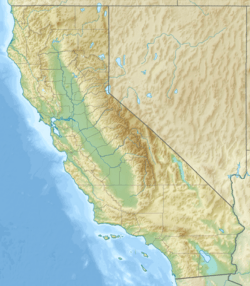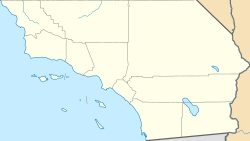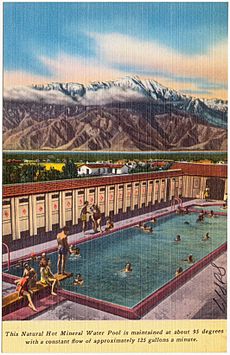Desert Hot Springs, California facts for kids
Quick facts for kids
Desert Hot Springs, California
|
|
|---|---|

Location of Desert Hot Springs in Riverside County, California.
|
|
| Country | United States |
| State | California |
| County | Riverside |
| Incorporated | September 25, 1963 |
| Area | |
| • Total | 30.66 sq mi (79.41 km2) |
| • Land | 30.27 sq mi (78.40 km2) |
| • Water | 0.39 sq mi (1.01 km2) 0.11% |
| Elevation | 1,076 ft (328 m) |
| Population
(2020)
|
|
| • Total | 32,512 |
| • Density | 1,074.03/sq mi (414.68/km2) |
| Time zone | UTC-8 (Pacific) |
| • Summer (DST) | UTC-7 (PDT) |
| ZIP codes |
92240–92241
|
| Area codes | 442/760 |
| FIPS code | 06-18996 |
| GNIS feature IDs | 1656484, 2410328 |
Desert Hot Springs is a city in Riverside County, California, United States. The city is located within the Coachella Valley geographic region. The population was 25,938 at the 2010 census, up from 16,582 at the 2000 census. The city has experienced rapid growth since the 1970s, when there were 2,700 residents.
It is named for its many natural hot springs. It is one of several places in the world with naturally occurring hot and cold mineral springs. More than 20 natural mineral spring lodgings can be found in town. Unlike hot springs with a high sulfur content, the mineral springs in town are odorless.
Contents
History
According to early homesteader and writer Cabot Yerxa in his newspaper columns published in The Desert Sentinel newspaper, the first homesteader in the area of the city of Desert Hot Springs was Hilda Maude Gray, who staked her claim in 1908. Cabot Yerxa arrived in 1913 and soon discovered the hot water aquifer on Miracle Hill. Due to the Mission Creek Branch of the San Andreas Fault bisecting the area, one side is a cold water aquifer, the other has a hot water aquifer. His large Pueblo Revival Style architecture structure, hand built over 20 years, is now one of the oldest adobe-style buildings in Riverside County, and houses Cabot's Pueblo Museum, designated a state historical site after his death in 1965. Cabot's Trading Post & Gallery opened there in February 2008.
The town was founded by L. W. Coffee on July 12, 1941. The original town site was centered at the intersection of Palm Drive and Pierson Boulevard and was only one square mile. Coffee chose the name Desert Hot Springs because of the area's natural hot springs.
Desert Hot Springs became a tourist destination in the 1950s because of its small spa hotels and boutique hotels. The city is popular with "snowbirds."
Realtors arrived to speculate, and thousands of lots and streets were laid out over a six square mile area. Some homes were bought by retirees and the area incorporated as a city in 1963, with 1,000 residents.
Desert Hot Springs experienced periods of significant growth in the 1980s and 1990s, when most of the vacant lots were filled with new houses and duplex apartments. The city's population doubled in the 1980s and increased by 5,000 in the 2000 census.
In 1993, a 3-star hotel, Mirage Springs Hotel Resort opened in DHS. Despite good reviews and providing much needed financial revenue to DHS, Mirage Springs closed its doors in 1998. The business reopened as the Miracle Springs Resort and Spa.
Desert Hot Springs High School opened in 1999.
Desert Local News, is an online news source. The Desert Star Weekly newspaper is published in the city.
Geography
According to the United States Census Bureau, the city has a total area of 23.6 square miles (61 km2), of which 99.89% is land and 0.11% is water.
Climate
Desert Hot Springs has a desert climate (Köppen climate classification BWh) similar to the rest of the Coachella Valley, with less than six inches of precipitation per year. Summers are very hot with days frequently exceeding 107 °F (42 °C) in July and August while night-time lows tend to stay between 78–90 °F (26–32 °C). The winters are mild with days typically seeing temperatures between 68–82 °F (20–28 °C) and corresponding night-time lows between 50–65 °F (10–18 °C). Heat waves during the summer months involving temperatures higher than 110 °F (43 °C) are not unusual.
| Climate data for Palm Springs Int'l Airport (1981–2010 normals) | |||||||||||||
|---|---|---|---|---|---|---|---|---|---|---|---|---|---|
| Month | Jan | Feb | Mar | Apr | May | Jun | Jul | Aug | Sep | Oct | Nov | Dec | Year |
| Record high °F (°C) | 95 (35) |
99 (37) |
104 (40) |
112 (44) |
116 (47) |
121 (49) |
123 (51) |
123 (51) |
121 (49) |
116 (47) |
102 (39) |
93 (34) |
123 (51) |
| Average high °F (°C) | 65.0 (18.3) |
73.9 (23.3) |
80.5 (26.9) |
87.5 (30.8) |
95.6 (35.3) |
103.6 (39.8) |
108.1 (42.3) |
107.3 (41.8) |
101.7 (38.7) |
91.1 (32.8) |
78.4 (25.8) |
66.0 (18.9) |
88.2 (31.2) |
| Average low °F (°C) | 35.0 (1.7) |
48.0 (8.9) |
52.2 (11.2) |
57.4 (14.1) |
64.4 (18.0) |
71.0 (21.7) |
77.6 (25.3) |
77.6 (25.3) |
71.7 (22.1) |
62.5 (16.9) |
50.0 (10.0) |
44.2 (6.8) |
59.3 (15.2) |
| Record low °F (°C) | 19 (−7) |
24 (−4) |
29 (−2) |
34 (1) |
36 (2) |
44 (7) |
54 (12) |
52 (11) |
46 (8) |
30 (−1) |
23 (−5) |
23 (−5) |
19 (−7) |
| Average precipitation inches (mm) | 1.15 (29) |
1.11 (28) |
0.53 (13) |
0.06 (1.5) |
0.02 (0.51) |
0.02 (0.51) |
0.13 (3.3) |
0.29 (7.4) |
0.23 (5.8) |
0.24 (6.1) |
0.32 (8.1) |
0.87 (22) |
4.97 (126) |
| Average precipitation days (≥ 0.01 in) | 3.1 | 3.2 | 1.6 | 0.6 | 0.2 | 0 | 0.6 | 0.9 | 0.8 | 0.7 | 0.8 | 1.9 | 14.4 |
| Source: NOAA | |||||||||||||
Geology
The Mission Creek Fault, a branch of the San Andreas, separates two aquifers. On one side, the Desert Hot Springs Sub-Basin contains an aquifer with hot water. This aquifer supports the area's spas and resorts. Mission Springs Sub-basin, on the other side of the fault, the Miracle Creek sub-basin has cold water. This aquifer provides fresh water to the city and has received awards for exceptional taste.
Demographics
| Historical population | |||
|---|---|---|---|
| Census | Pop. | %± | |
| 1960 | 1,472 | — | |
| 1970 | 2,738 | 86.0% | |
| 1980 | 5,941 | 117.0% | |
| 1990 | 11,668 | 96.4% | |
| 2000 | 16,582 | 42.1% | |
| 2010 | 25,938 | 56.4% | |
| 2020 | 32,512 | 25.3% | |
| U.S. Decennial Census | |||
2010
From having 20 residents in 1941, Desert Hot Springs had 28,000 residents in 2014.
The 2010 United States Census reported that Desert Hot Springs had a population of 25,938. The population density was 1,097.1 people per square mile (423.6/km2). The racial makeup of Desert Hot Springs was 15,053 (58.0%) White (34.4% Non-Hispanic White), 2,133 (8.2%) African American, 357 (1.4%) Native American, 675 (2.6%) Asian, 84 (0.3%) Pacific Islander, 6,343 (24.5%) from other races, and 1,293 (5.0%) from two or more races. Hispanic or Latino of any race were 13,646 persons (52.6%).
The Census reported that 25,820 people (99.5% of the population) lived in households, 118 (0.5%) lived in non-institutionalized group quarters, and 0 (0%) were institutionalized.
There were 8,650 households, out of which 3,713 (42.9%) had children under the age of 18 living in them, 3,468 (40.1%) were opposite-sex married couples living together, 1,603 (18.5%) had a female householder with no husband present, 711 (8.2%) had a male householder with no wife present. There were 843 (9.7%) unmarried opposite-sex partnerships, and 206 (2.4%) same-sex married couples or partnerships. 2,071 households (23.9%) were made up of individuals, and 691 (8.0%) had someone living alone who was 65 years of age or older. The average household size was 2.98. There were 5,782 families (66.8% of all households); the average family size was 3.59.
The ages of the resident population range from 8,064 people (31.1%) under the age of 18, 2,712 people (10.5%) aged 18 to 24, 6,893 people (26.6%) aged 25 to 44, 5,781 people (22.3%) aged 45 to 64, to 2,488 people (9.6%) who were 65 years of age or older. The median age was 31.0 years. For every 100 females, there were 100.3 males. For every 100 females age 18 and over, there were 98.4 males.
There were 10,902 housing units at an average density of 461.1 per square mile (178.0/km2), of which 4,166 (48.2%) were owner-occupied, and 4,484 (51.8%) were occupied by renters. The homeowner vacancy rate was 8.6%; the rental vacancy rate was 16.6%. 11,533 people (44.5% of the population) lived in owner-occupied housing units and 14,287 people (55.1%) lived in rental housing units.
According to the 2010 United States Census, Desert Hot Springs had a median household income of $32,883, with 28.6% of the population living below the federal poverty line.
2000
As of the census of 2000, there were 16,582 people, 5,859 households, and 3,755 families residing in the city. The population density was 713.2 people per square mile (275.4/km2). There were 7,034 housing units at an average density of 302.5 per square mile (116.8/km2). The racial makeup of the city was 68.2% white, 6.1% black or African American, 1.4% Native American, 2.0% Asian, 0.1% Pacific Islander, 16.4% from other races, and 5.8% multiracial. 40.4% of the population was Hispanic or Latino.
There were 5,859 households, out of which 38.7% had children under the age of 18 living with them, 39.3% were married couples living together, 17.9% had a female householder with no husband present, and 35.9% were non-families. 27.6% of all households were made up of individuals, and 9.9% had someone living alone who was 65 years of age or older. The average household size was 2.8 and the average family size was 3.5.
In Desert Hot Springs the age of the population was spread out, with 33.3% under the age of 18, 9.7% from 18 to 24, 29.4% from 25 to 44, 16.5% from 45 to 64, and 11.1% who were 65 years of age or older. The median age was 30 years. For every 100 females, there were 96.8 males. For every 100 females age 18 and over, there were 91.6 males. Desert Hot Springs has a reputation as an active adult community, where many retirees choose to live.
The median income for a household in the city was $25,987, and the median income for a family was $29,126. Males had a median income of $27,873 versus $21,935 for females. The per capita income for the city was $11,954. About 22.4% of families and 27.5% of the population were below the poverty line, including 37.1% of those under age 18 and 15.0% of those age 65 or over, one of the highest for cities over 10,000 in southern California.
Diversity
Desert Hot Springs has a diverse population. Several racial or ethnic groups live there, with the largest group being of Mexican and Central American ancestry. There is a Korean American ethnic section of the city at 8th Street and Cholla Drive. Thousands of American Jews made the city their home. According to the Desert Chapter of the National Association for the Advancement of Colored People (NAACP), the city's population is over 10 percent African-American or Black. The city has a high proportion of Native Americans, most of whom are members of the Cahuilla tribe in proximity to the Agua Caliente Cahuilla tribal board in Palm Springs. A large percentage of the city population is LGBTQ.
Municipal bankruptcy
In 2001 the town filed for a Chapter 9 municipal bankruptcy. The bankruptcy was resolved in 2004 by selling municipal bonds when it faced a legal judgment of almost $6 million.
Boutique hotels and spas
Desert Hot Springs is home to a number of hot mineral water spas. During the 1950s and 1960s the town had over 80 spa hotels, often called "spa-tels." From the late 1990s to the present a number of these boutique hotels have been renovated and revived. With their mid-century modern architecture they appeal to those wanting a unique hotel / spa experience.
One famous spa hotel property in Desert Hot Springs is the Two Bunch Palms Resort. In 1992 it was used as a filming location for the movie The Player. [1]
In 2001 Huell Howser Productions, in association with KCET/Los Angeles, featured the Desert Hot Springs Hotel and Spa in California's Gold.
Modernist architecture
At one time there were 43 small spas (6 to 10 guest rooms) in the city. Some were located atop the hot water aquifer on Miracle Hill, where Cabot Yerxa, one of the early settlers lived. His home is now Cabot's Pueblo Museum. Across the street is Miracle Manor Retreat, one of the first spas built (1949) in the town. It was built by the Martin Family who eventually sold it in 1981 to a local legend, Lois Blackhill. Upon her death in 1996, her family sold it in 1997, to two longtime regulars and close friends of Lois', trans-media designer April Greiman and architect-educator Michael Rotondi. It was restored to its original state, with improvements and renamed Miracle Manor Retreat. They are credited with pioneering the 'boutique spa' movement in the city. The Desert Hot Springs Motel, designed by architect John Lautner is located just outside the city limits. The motel was purchased and restored in 2000 by Steven Lowe.
In 2006 the architectural firm of Marmol Radziner + Associates designed a sustainable, modernist prefab home featured in the November 2006 issue of Dwell magazine. The home served as a prototype for the firm's efforts to develop a series of prefab homes.
Economy
The city is home to windmill farms in the west and also by the San Gorgonio Pass. Growing use of solar power accompanied with many windmills make Desert Hot Springs a leading city in renewable energy.
The main economy is based on spas, which are mostly owner-operated. The mild climate and hot springs make it a popular tourist destination.
Municipal bankruptcy
In 2001 the town filed for a Chapter 9 municipal bankruptcy. The bankruptcy was resolved in 2004 by selling municipal bonds when it faced a legal judgment of almost $6 million.
Hot mineral water spas
Desert Hot Springs is home to a number of hot mineral water spas. During the 1950s and 1960s the town had over 80 spa hotels. From the late 1990s to the present a number of these boutique hotels have been renovated and revived. With their mid-century modern architecture they appeal to those wanting a unique hotel / spa experience.
Some of the better known spa hotels in Desert Hot Springs include:
- The Miracle Springs Resort & Spa, which has been the filming location for multiple movie productions, including Mulholland Falls, Senior Moment, and Hot Springs Hotel.
- The Two Bunch Palms Resort, which was used as a 1992 filming location for the movie The Player.
- The Desert Hot Springs Hotel and Spa, which was featured on California's Gold In 2001 by Huell Howser Productions, in association with KCET/Los Angeles.
Notable people
Although never a resident, Marilyn Monroe occasionally visited the spas in Desert Hot Springs. She spent a week in the town shortly before her death.
- Coco Crisp, MLB-player
- John L. Gaunt, photographer
- Janet Gaynor, actress
- Gus Henderson, football coach
- Knute Hill, Democratic politician
- Paul Krassner, author, journalist, comedian
- Noel Langley, South African novelist
- Robert McAlmon, author
- Jerome Storm, film director
- Joan Woodbury, actress
- Rick Zumwalt, wrestler
Images for kids
See also
 In Spanish: Desert Hot Springs para niños
In Spanish: Desert Hot Springs para niños








